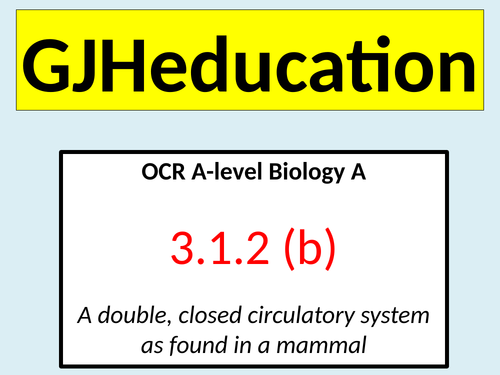



This fully-resourced lesson looks at the type of circulatory system found in a mammal (double, closed) and considers how the pulmonary circulation differs from the systemic circulation. The engaging PowerPoint and accompanying resources have been designed to cover point 3.1.2 (b) of the OCR A-level Biology A specification
The lesson begins with a focus on the meaning of a double circulatory system and checks that students are clear in the understanding that the blood passes through the heart twice per cycle of the body. Beginning with the pulmonary circulation, students will recall that the pulmonary artery carries the blood from the right ventricle to the lungs. An opportunity is taken at this point to check on their knowledge of inhalation and the respiratory system as well as the gas exchange between the alveoli and the capillary bed. A quick quiz is used to introduce arterioles and students will learn that these blood vessels play a crucial role in the changes in blood pressure that prevent the capillaries from damage. When looking at the systemic circulation, time is taken to look at the coronary arteries and renal artery as students have to be aware of these vessels in addition to the ones associated with the heart. In the final part of the lesson, students are challenged to explain how the structure of the heart generates a higher pressure in the systemic circulation and then to explain why the differing pressures are necessary.
This lesson has been written to tie in with the other uploaded lessons from topic 3.1.2 (transport in animals)
Get this resource as part of a bundle and save up to 44%
A bundle is a package of resources grouped together to teach a particular topic, or a series of lessons, in one place.
Module 3: Exchange and transport (OCR A-level Biology A)
This bundle contains 18 detailed and engaging lessons which cover the following specification points in module 3 (Exchange and transport) of the OCR A-level Biology A specification: 3.1.1: Exchange surfaces * The need for specialised exchange surfaces * The features of an efficient exchange surface * The structures and functions of the components of the mammalian gaseous exchange system * The mechanism of ventilation in mammals * The mechanisms of ventilation and gas exchange in bony fish and insects 3.1.2: Transport in animals * The double, closed circulatory system in mammals * The structure and functions of arteries, arterioles, capillaries, venules and veins * The formation of tissue fluid from plasma * The external and internal structure of the heart * The cardiac cycle * How heart action is initiated and coordinated * The use and interpretation of ECG traces * The role of haemoglobin in transporting oxygen and carbon dioxide * The oxygen dissociation curve for foetal and adult haemoglobin 3.1.3: Transport in plants * The structure and function of the vascular systems in the roots, stems and leaves * The transport of water into the plant, through the plant and to the air surrounding the leaves * The mechanism of translocation As well as the detailed A-level Biology content of the PowerPoint slides, the resources contain a wide range of tasks including guided discussion points, exam-style questions and quiz competitions which will engage and motivate the students
Module 3.1.2: Transport in animals (OCR A-level Biology)
Each of the 9 lessons in this bundle are fully-resourced and have been designed to cover the content as detailed in module 3.1.2 (Transport in animals) of the OCR A-Level Biology A specification. The specification points that are covered within these lessons include: * A double, closed circulatory system * The structure and function of arteries, arterioles, capillaries, venules and veins * The formation of tissue fluid from plasma * The internal and external structure of the mammalian heart * The cardiac cycle * How heart action is initiated and coordinated * The use and interpretation of ECGs * The role of haemoglobin in transporting oxygen and carbon dioxide * The dissociation curve for foetal and adult haemoglobin * The Bohr effect The lessons have been written to include a wide range of activities and numerous understanding and prior knowledge checks so students can assess their progress against the current topic as well as be challenged to make links to other topics within this topic and earlier topics If you would like to see the quality of the lessons, download the formation of tissue fluid. heart action and ECGs lessons as these are free
Something went wrong, please try again later.
This resource hasn't been reviewed yet
To ensure quality for our reviews, only customers who have purchased this resource can review it
Report this resourceto let us know if it violates our terms and conditions.
Our customer service team will review your report and will be in touch.